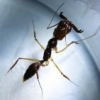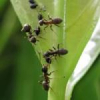In no particular order:
The binomial (two-part, genus-species) species name for any organism is always written in italic font, although other levels of classification, such as subfamily, are not italicized. The first letter of the genus is ALWAYS capitalized, and the first letter of the species is NEVER capitalized. ONLY the genus may be abbreviated to the first one or two letters, but ONLY after the name has been spelled in full at least once. (i.e. Lasius alienus, L. alienus, Pheidole bicarinata, Ph. bicarinata)
sp.
is an abbreviation for "species", describing A SINGLE, unspecified member of a given genus (i.e. Lasius sp.)
spp.
is an abbreviation for "species pluralis", describing MULTIPLE, DIFFERENT, unspecified members of a given genus (i.e. Lasius spp.)
cf.
is an abbreviation which roughly translates to "comparable to". It goes between the genus and species of something that is comparable to your specimen, but is not proven to be that species. Any specimen we call Lasius cf. neoniger could possibly be Lasius pallitarsis, unless we can prove otherwise.
Sometimes people will use the informal formicine, myrmicine, ponerine, etc. to describe their ants, based on subfamily. These do not need to be capitalized or italicized, but note that these words ARE ADJECTIVES. Saying "this is a myrmicine." as opposed to "this is a myrmicine ant." is akin to saying "this is an interesting." as opposed to "this is an interesting ant."
Polygyny refers to ants which are polygynous, supporting more than one queen in a colony after it is founded. Polygyny is typically not a universal trait for a given species, but is often expressed through branching genetic lineages (it is only advantageous to be polygynous when there is heavy competition from your own species and little available space to found a new colony.) In many instances of polygyny (particularly with polydomic ants who have multiple, allied nests) the extra queens are daughters of the foundress queen who have rejoined the colony.
Monogyny describes ants which will only ever support one queen after their colony is founded. Species which exhibit polygyny will likely also have a monogynous strain, and the two strains tend to be intolerant of each other.
"Mono" and "poly", "monogamous" and "polygamous" refer ONLY to human partnerships! ![]()
"Mono" is also appropriate to describe infectious mononucleousus, caused by the Epstein–Barr virus.
Pleometrosis refers to a founding strategy wherein a colony is started with more than one queen, although, later, all but one will move away with or without a portion of the workers (or else be killed off). The adjective form is "pleometrotic", not "pleometrophic", which would mean "eats queens".
A NAN-I-TIC is a morphologically distinct caste of worker found at the beginning of a colony's founding stages. Nanitics are usually smaller, short-lived, and may be a different shape or color.
I'll probably be adding more to this later. Glad to get that off my chest. ![]()
Edited by Batspiderfish, April 18 2017 - 7:21 AM.
























